Among the endangered mammals are the snow leopards, Flare horned Markhors, Marco Polo sheep, Ladakh Urial, musk deer, brown bear, and woolly lying squirrel. The population of many bird species like the rare snow cock and Monal pheasant is so depleted as to be heading towards extinction in the wild. Although no systematic studies have been conducted to evaluate the status of many of these species, some site-specific studies indicate that populations of these species is very low indeed.
The main reasons for such decline are over hunting, loss of habitat and fragmentation. The Astore markhor and Ladakh urial occurred at lower elevations and were under heavy hunting pressure both for meat and trophies. The musk deer has also been hunted so much for its scented pod that now it is considered endangered.
 The present total population of snow leopards in the wild is estimated at around 4,000 in the world. The snow leopard has thick, wide great smoky greyish fur with black rosettes and destinations, and a very lengthy wide trail. Considering up to 75 kg (165 lb), it has huge, well-cushioned feet, a powerful chest area, and short forelimbs that allow it to range outcroppings great on coves. Further variations for high-altitude life involve lengthy hair with heavy, woolly underfur and an increased nose...
The present total population of snow leopards in the wild is estimated at around 4,000 in the world. The snow leopard has thick, wide great smoky greyish fur with black rosettes and destinations, and a very lengthy wide trail. Considering up to 75 kg (165 lb), it has huge, well-cushioned feet, a powerful chest area, and short forelimbs that allow it to range outcroppings great on coves. Further variations for high-altitude life involve lengthy hair with heavy, woolly underfur and an increased nose...
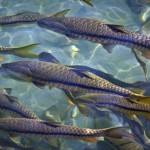 Native to Pakistan, Golden Mahaseer are common in Malaysia, Indonesia, across southern Asia to Iran, including the Indian Peninsula as well. It is a popular game-fish, the largest species of mahseer, and can reach up to 2.75 m in length and 54 kg in weight, though most caught today are far smaller. It is threatened by habitat loss, habitat degradation and over fishing, and it is estimated that it already has declined by more than 50%. The species has been reported from across the Himalayan...
Native to Pakistan, Golden Mahaseer are common in Malaysia, Indonesia, across southern Asia to Iran, including the Indian Peninsula as well. It is a popular game-fish, the largest species of mahseer, and can reach up to 2.75 m in length and 54 kg in weight, though most caught today are far smaller. It is threatened by habitat loss, habitat degradation and over fishing, and it is estimated that it already has declined by more than 50%. The species has been reported from across the Himalayan...
 In all of the Asia, Cheetah is now extinct from nearly all of its territory. Its significant territory used to broaden from the shores of the Mediterranean and the Arabian Peninsula, north to the northern shores of the Caspian and Aral Seas, and west through Uzbekistan, Turkmenistan, Afghanistan, and Pakistan into central India. One reason for their regional extinction from nearly all of their Asian range is considered to have been the illegal capture of these wild cats. They were then trained to hunt down the game, mostly,...
In all of the Asia, Cheetah is now extinct from nearly all of its territory. Its significant territory used to broaden from the shores of the Mediterranean and the Arabian Peninsula, north to the northern shores of the Caspian and Aral Seas, and west through Uzbekistan, Turkmenistan, Afghanistan, and Pakistan into central India. One reason for their regional extinction from nearly all of their Asian range is considered to have been the illegal capture of these wild cats. They were then trained to hunt down the game, mostly,...
 The common leopard is listed as protected and illegal to hunt in all provincial laws of Pakistan. This wild cat is naturally associated with the humid temperate jungles that include both rain and coniferous jungles of the northern areas. Four subspecies of this big cat have been identified in the mammals’ directory of Pakistan, historically. On the other hand, it is hard to distinguish among the subspecies. The leopards are confined to the northern Pakistan with infrequent reports of sighting in...
The common leopard is listed as protected and illegal to hunt in all provincial laws of Pakistan. This wild cat is naturally associated with the humid temperate jungles that include both rain and coniferous jungles of the northern areas. Four subspecies of this big cat have been identified in the mammals’ directory of Pakistan, historically. On the other hand, it is hard to distinguish among the subspecies. The leopards are confined to the northern Pakistan with infrequent reports of sighting in...
 The Sociable Lapwing is a wader in the lapwing Aves family. This gorgeous medium-sized bird has long black legs and a short black bill. Summer adults covered with grey feathered back and breast, dark abdomen and white under the tail. The head has a prominent pattern, with a black circlet. The upper neck is ochre, white tail with a black terminal band and uniquely brown, white and grey wings make it almost instantly recognizable in flight. Length is 27–30 cm. The call is a harsh kereck.
These birds are native to...
The Sociable Lapwing is a wader in the lapwing Aves family. This gorgeous medium-sized bird has long black legs and a short black bill. Summer adults covered with grey feathered back and breast, dark abdomen and white under the tail. The head has a prominent pattern, with a black circlet. The upper neck is ochre, white tail with a black terminal band and uniquely brown, white and grey wings make it almost instantly recognizable in flight. Length is 27–30 cm. The call is a harsh kereck.
These birds are native to...
 This species of weasels is native to Pakistan and mature individuals continue to decline in numbers. Mountain Weasel range includes central and east Asia, with a range comprising China; Pakistan; the Himalaya in India (Kashmir eastward to Arunachal Pradesh), Nepal and Bhutan; eastern Kazakhstan, Kyrgyzstan, Tajikistan, Mongolia and parts of Siberia in the Russian federation.
Habitat and Ecology
Weasel occurs only in exterior closed jungle habitats, characteristically in alpine meadows, boulders area, and rocky slopes. They are also found in the dried out steppes and plains, waterway valleys that have reeds and undergrowth and alpine meadows. These mammals belong to...
This species of weasels is native to Pakistan and mature individuals continue to decline in numbers. Mountain Weasel range includes central and east Asia, with a range comprising China; Pakistan; the Himalaya in India (Kashmir eastward to Arunachal Pradesh), Nepal and Bhutan; eastern Kazakhstan, Kyrgyzstan, Tajikistan, Mongolia and parts of Siberia in the Russian federation.
Habitat and Ecology
Weasel occurs only in exterior closed jungle habitats, characteristically in alpine meadows, boulders area, and rocky slopes. They are also found in the dried out steppes and plains, waterway valleys that have reeds and undergrowth and alpine meadows. These mammals belong to...
 The great hammerhead, however, is the largest of the 9 species of hammerhead sharks and is reported to reach up to 6.1 m in length and weigh up to at least 581kg. These sharks have a flat hammer-shaped head with a notch at the center located along the front edge. Juveniles have slightly curved heads at the front margin that becomes nearly straight as they reach adulthood. This species can be identified by its nearly rectangular head. The first dorsal fin is very high and curved;...
The great hammerhead, however, is the largest of the 9 species of hammerhead sharks and is reported to reach up to 6.1 m in length and weigh up to at least 581kg. These sharks have a flat hammer-shaped head with a notch at the center located along the front edge. Juveniles have slightly curved heads at the front margin that becomes nearly straight as they reach adulthood. This species can be identified by its nearly rectangular head. The first dorsal fin is very high and curved;...
 Unfortunately there are hardly any good stories associated with this sub species of the Asiatic bear in Pakistan. It used to be widely distributed in the majority of Balochistan but now it is listed as critically endangered in Pakistan and extinct in most of the natural habitat locally. These bears have adapted well over centuries and are covered in an uncommonly thin coat as compared to the Asian black bear. The obvious reason for this is that, this species is located in a warmer climate...
Unfortunately there are hardly any good stories associated with this sub species of the Asiatic bear in Pakistan. It used to be widely distributed in the majority of Balochistan but now it is listed as critically endangered in Pakistan and extinct in most of the natural habitat locally. These bears have adapted well over centuries and are covered in an uncommonly thin coat as compared to the Asian black bear. The obvious reason for this is that, this species is located in a warmer climate...
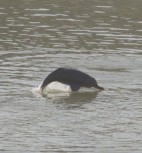 The Indus River dolphin is one of the world's rarest mammals that is critically endangered with an estimate of 1000 living in the wild as reported by IUCN. The Indus River Dolphin has a long beak and a stocky body. It has a low triangular hump on its back in place of a 'true' dorsal fin. It is gray-brown in color, sometimes with a pinkish belly. The eyes are extremely small, resembling pinhole openings slightly above the mouth. The...
The Indus River dolphin is one of the world's rarest mammals that is critically endangered with an estimate of 1000 living in the wild as reported by IUCN. The Indus River Dolphin has a long beak and a stocky body. It has a low triangular hump on its back in place of a 'true' dorsal fin. It is gray-brown in color, sometimes with a pinkish belly. The eyes are extremely small, resembling pinhole openings slightly above the mouth. The...
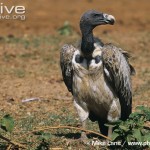 Commonly identified as Long-billed Vulture, the Indian Vulture breeds mainly on crags in the mountains of Pakistan and India. It is a forager and a scavenger, feeding on dead animals which it finds by towering in flocks over savanna and around human being habitation. It has hairless head, very wide wings and short tail feathers. It weighs 12 to 14 lbs, measures 2.5-3.25 feet in length, and has a wingspan of 6.5 - 7.5 feet.
The Indian vulture is known to breeds in south-east of Pakistan and in the Gangetic plains,...
Commonly identified as Long-billed Vulture, the Indian Vulture breeds mainly on crags in the mountains of Pakistan and India. It is a forager and a scavenger, feeding on dead animals which it finds by towering in flocks over savanna and around human being habitation. It has hairless head, very wide wings and short tail feathers. It weighs 12 to 14 lbs, measures 2.5-3.25 feet in length, and has a wingspan of 6.5 - 7.5 feet.
The Indian vulture is known to breeds in south-east of Pakistan and in the Gangetic plains,...
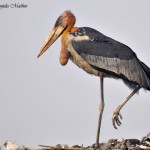 Habitat
While breeding in the dry time of year (May, June and October) it dwells in swamps, nesting in high woods, bamboo forests and traditionally on rock faces. Breeding is considered to match with the dry season to catch the benefits of plentiful kill as stream levels draws back. In north India, it takes place close to town areas, feeding about marshlands in the breeding season, and dispersing to forage at garbage dumps, abattoirs and interment grounds at other period. In Cambodia, it mates in fresh water swamped woods and areas...
Habitat
While breeding in the dry time of year (May, June and October) it dwells in swamps, nesting in high woods, bamboo forests and traditionally on rock faces. Breeding is considered to match with the dry season to catch the benefits of plentiful kill as stream levels draws back. In north India, it takes place close to town areas, feeding about marshlands in the breeding season, and dispersing to forage at garbage dumps, abattoirs and interment grounds at other period. In Cambodia, it mates in fresh water swamped woods and areas...
 The National Animal of Pakistan and only a few thousands survive in the wild now. The reasons Markhor faces a very high risk of extinction in the near future include intensive hunting (for trophies, meat and the Asian medicine market), disturbance and loss of habitat due to expanded human settlement, and competition from domestic livestock.
The markhor is a member of the goat family which may weigh up to 110 kg (240 lb). It has unusual spiraling horns which may be straight or flare outward, depending...
The National Animal of Pakistan and only a few thousands survive in the wild now. The reasons Markhor faces a very high risk of extinction in the near future include intensive hunting (for trophies, meat and the Asian medicine market), disturbance and loss of habitat due to expanded human settlement, and competition from domestic livestock.
The markhor is a member of the goat family which may weigh up to 110 kg (240 lb). It has unusual spiraling horns which may be straight or flare outward, depending...
 The only region in Pakistan where this species is found is the southern swamp forests, large rivers and mangrove jungles. Major threats to local otter inhabitants are loss of wetlands due to production of hydroelectric power plants, recuperation of wetlands for human colonies and cultivation, lessening of prey because of habitat loss, poaching and pollution of water channel by insect killers. In the majority Asian countries enlarged inhabitants during the last few decades, insufficient and unproductive rustic growth programs have not been capable to deal with the...
The only region in Pakistan where this species is found is the southern swamp forests, large rivers and mangrove jungles. Major threats to local otter inhabitants are loss of wetlands due to production of hydroelectric power plants, recuperation of wetlands for human colonies and cultivation, lessening of prey because of habitat loss, poaching and pollution of water channel by insect killers. In the majority Asian countries enlarged inhabitants during the last few decades, insufficient and unproductive rustic growth programs have not been capable to deal with the...
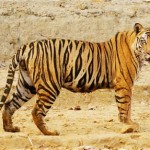 Tiger got extinct in what is today known as Pakistan roughly in 1906 but a few may have been accounted until 1933. Tigers lived over to a large extent of Sindh, lower NWFP and Punjab. Yes, that's...
Tiger got extinct in what is today known as Pakistan roughly in 1906 but a few may have been accounted until 1933. Tigers lived over to a large extent of Sindh, lower NWFP and Punjab. Yes, that's...
 The species was there in a huge number, in Pakistan and other southern parts of Asia but until the nineties. White-rumped Vulture population has suffered decline swiftly. This is unbelievably up to 99.9% in the 15 year span from 1992 to 2007. In 1986 the species was illustrated as probably†the most plentiful large bird of prey on the planet and was considered an annoyance but is now extremely rare facing extinction in the near future.
These Vultures are normal sized birds and featherless head...
The species was there in a huge number, in Pakistan and other southern parts of Asia but until the nineties. White-rumped Vulture population has suffered decline swiftly. This is unbelievably up to 99.9% in the 15 year span from 1992 to 2007. In 1986 the species was illustrated as probably†the most plentiful large bird of prey on the planet and was considered an annoyance but is now extremely rare facing extinction in the near future.
These Vultures are normal sized birds and featherless head...















this is absurd.. completely pathetic information.. im going thhrough a an emotional trauma…. my loved ones left me 🙁 no one caressss… no onee!!!!! not even you’ll… all you guys care about is the animals getting extinct.. what about me? what about humansss?? are we nothinggggg?!?!
I have an assignment on “Endangered Spp.” but Unfortunately from other webs i can not learn so much as from this. this was a good information concerning to this topic. but some other spp are also not involved there.
Thank you dear Farhan. I am working on adding more related info regarding the endangered species in Pakistan.